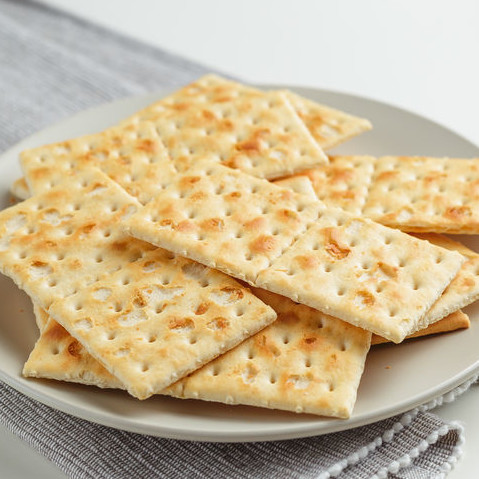
Crackers
What are Crackers?
Crackers are baked goods characterized by their low moisture content, hard bite and long shelf-life, compared to bread and buns.
They come in an infinite variety of shapes, colors, flavors, textures and composition. As with other baked goods such as cookies and English biscuits, crackers have a low water activity and can be stored for long periods of time without losing their original quality.1
How are crackers made?
Crackers are made with wheat flour, water, yeast or chemical leaveners, and inclusions of fat, sugar and other enriching ingredients.
There are two major types:2
- Soda crackers (saltine-type)
- Snack crackers (enzyme/chemical type)
Soda crackers are fermented and usually made with the sponge and dough system. This type of cracker is rather dry and has a flaky layered structure.
Enzyme crackers are in most cases chemically-leavened products and are made using proteolytic enzymes. These reduce the elasticity of the dough and impart sheetability. This type of cracker is usually sprayed with oil immediately after baking.
Chemical crackers are similar to enzyme crackers in shape and size. However, the main difference is that they are formulated with reducing agents to improve machining and optimum processing. L-cysteine and sodium bisulfites are commonly used as reducing agents.
Formulation of soda crackers (yeast-leavened)
Soda crackers normally do not contain added sugar. Also, the fat or shortening level is quite low, compared to other biscuits or cookies.
Sponge (70% pre-fermentation of flour):
| Ingredients | Baker’s % (based on total flour weight) |
| Wheat flour* | 70.0 |
| Water | 35.0 |
| Yeast (compressed) | 0.2–0.3** |
| Lactic acid bacteria starter (or old sponge) | 1.0–4.0 |
| Lecithin | 0.5–0.8 |
| Total | 103.7 |
*Milled from hard red spring (HRS), hard red winter (HRW). Can also be high gluten flour (>13% protein)
**Yeast amount for 16–20-hour sponge fermentation
Dough formulation (40% total hydration):
| Ingredients | Baker’s % |
| Wheat flour (hard/soft blend) | 30.0 |
| Water | 5.0 |
| Salt | 2.0 |
| Shortening / butter | 10.0–12.0 |
| Diastatic malt (malt extract) | 0.5–1.0 |
| Ammonium / sodium bicarbonate | 0.5–1.2* |
| Proteolytic enzyme | 0.005 (50 ppm) |
| Sponge | 103.7 |
| Total | 154.7 |
*Amount varies (enough to bring pH of final dough to 6.0–8.0)
Commercial production
- Ingredient scaling/metering.
- Sponge preparation.
- Mixing: mix ingredients at low speed for 2–3 minutes to incorporate the ingredients evenly.
- Fermentation: allow the sponge to ferment for 16–20 hours at 80°F (27°C) and 75% RH. TTA, pH and temperature require monitoring.
- Initial pH: 6.0
- Final pH: 4.0
- Mixing: remixing of sponge with dough-side ingredients (with the addition of base, the pH of the dough reaches a slightly alkaline pH).
- Dough resting: let the final dough rest for 3 to 5 hours at the same conditions as sponge.
- Pre-sheeting of dough: bulk dough is sheeted in preparation for final forming.
- Laminating: dough is laminated with 4 to 6 layers of a preset thickness.
- Dough gauging by reduction rollers: final thickness of 2–4 mm.
- Dough docking and cutting (rotary cutter or stamping cutter with docking holes).
- Topping / salting.
- Baking: bake the product in a 4-zone direct gas-fired oven, on a heavy mesh oven band for 2–4 minutes at a temperature profile of 572/572/536/482°F (300/300/280/250°C).
- Oil spraying (optional).
- Cooling.
- Stacking / packing.
Application
Here are some things to consideration with cracker production:
- Premium or high-quality soda crackers require more time because the sponge fermentation and dough resting operations are fairly long.
- Sufficient space and a separate fermentation room are required to produce soda crackers.
- Cracker doughs spring or expand in the first section of the oven to achieve an open, flaky texture. This requires high humidity in the oven atmosphere (exhaust dampers closed) and high heat transfer in zone 1.
- All types of crackers are baked to very low moisture content (1.5–2.5%). This requires a powerful oven with a high energy output from burners to evaporate water from the product in the relatively short baking time.
- Heavy mesh oven bands are typically used for baking crackers. These bands require preheating to quickly transfer heat to dough pieces by conduction.
References
- Davidson, I. “The Biscuits.” Biscuit Baking Technology. Processing and Engineering Manual, 2nd Edition, Academic Press, Elsevier Inc., 2016, pp. 1–34.
- Manley, D. Manley’s Technology of Biscuits, Crackers and Cookies, 4th Edition, Woodhead Publishing Limited, 2011, pp. 271–302.

